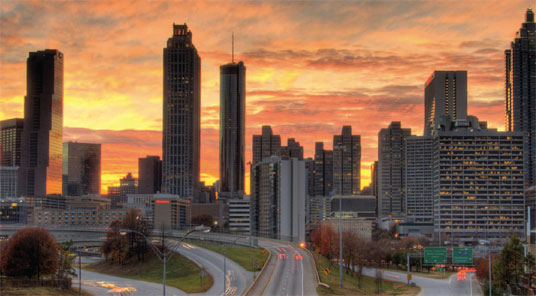Navigating Atlanta
Your Guide to Local Roads and Public Transit
by Muriel Vega

Downtown Atlanta at sunset.
For a new resident, finding your way around Atlanta can be
intimidating. It’s a big place, after all, with different neighborhoods and landmarks spread out across a metropolitan area that stretches across several counties. And then there are all those highways criss-crossing the city to keep track of. To help you get your bearings, we’ve broken down some of the major streets, interstates and public-transportation options you’ll need to know.Main Roads and Highways
There are dozens of streets in Atlanta with a “Peachtree” in the name, but there’s really only one Peachtree Street. Atlanta’s Main Street begins in the Five Points area of downtown, passing such landmarks as the Georgia-Pacific Tower and the Westin Peachtree Plaza Hotel before crossing into Midtown, where you’ll encounter the Fox Theatre, the Margaret Mitchell House and the Woodruff Arts Center (home of the High Museum of Art). Continuing north toward Buckhead, the district famous for its shopping and hotels, the street becomes Peachtree Road and passes on through Brookhaven.Other prominent roads to know are West Peachtree Street, which runs parallel to Peachtree in downtown and Midtown; Ponce de Leon Avenue, which begins in Midtown and travels to Decatur; and Buford Highway, the area’s center of international culture and cuisine, located primarily in DeKalb County.
The Downtown Connector is the unofficial name of the approximately 7.5-mile stretch of highway where Interstates 75 and 85 merge as they pass through downtown Atlanta. Also known as 75/85, the Connector begins near Hartsfield-Jackson Atlanta International Airport at the Langford Parkway exit, and runs north past Turner Field, passing the campuses of Georgia State University and Georgia Tech. The Connector ends in Midtown at an interchange known as the Brookwood Split.
A good deal of metro Atlanta is accessible via Interstate 85. Heading south from the Connector, I-85 leads to East Point, College Park and the airport; its northward stretch passes Chamblee, Doraville, Duluth and Suwanee on its way out of the state. Just after Suwanee, it splits off into Interstate 985, which leads to Buford, Flowery Branch and Gainesville.
After splitting with I-85, Interstate 75 heads northwest, climbing through Smyrna, Marietta and Kennesaw on its way toward Chattanooga, Tenn. Its southern stretch heads southeast toward Macon and, eventually, Florida. Interstate 20, meanwhile, passes Six Flags Over Georgia on its way into Atlanta, crossing the Connector and Interstate 285 on its way east.
Approximately 64 miles long, Interstate 285 is also known as “the Perimeter” because it forms a circle around the city. From East Point, it travels north toward Smyrna, arcing east past Sandy Springs and then south through Doraville, Tucker and Stone Mountain, looping westward toward the airport and College Park. Two major landmarks along this route are Spaghetti Junction, where it merges with I-85 near Tucker, and the Cobb Cloverleaf, where it connects with I-75 northwest of the city.
Georgia State Route 400, also known as Georgia 400, is a toll road that splits off from I-85 and cuts through Buckhead, Sandy Springs, Roswell, Alpharetta and Cumming, after which it downgrades from a freeway to a surface road near North Georgia Premium Outlets in Dawsonville. The major landmarks along this road are the King and Queen buildings, a pair of distinctive office towers. The toll plaza collects fares for both north- and southbound drivers near Buckhead. The tolls are currently slated to cease at the end of 2013.
Public Transportation
The Metropolitan Atlanta Rapid Transit Authority (MARTA) provides rail and bus service to the metro Atlanta area, with four rail lines operating primarily in Fulton and DeKalb counties. All four rail lines connect, offering transfers at the Five Points station located off Peachtree Street. The fee for traveling one way is $2.50 including transfers, and payment is easy with prepaid MARTA Breeze cards, which can be purchased at train stations.The Gold and Red lines travel a north-south trajectory, while the Blue and Green lines take an east-west route that runs mostly through the city of Atlanta. The Gold line goes from the airport through downtown and the business district, past Lenox Square Mall and Chamblee to end in Doraville. The Red line makes the same trek from the airport through the downtown area but splits after the Lindbergh station and heads toward Buckhead and Dunwoody, ending near Sandy Springs.
The Blue line is the longest route, covering Decatur, Candler Park, Inman Park, Grant Park and Cabbagetown. To the west, it stops at several landmarks, including the CNN Center, Centennial Olympic Park and the Georgia Dome. The Green line starts at Edgewood and splits from the Blue line after the Vine City neighborhood, terminating in Bankhead to the west of the city.
To complement the rail service, MARTA offers bus and shuttle service. Bus stops are located throughout metro Atlanta with affordable fares and reliable schedules. MARTA also offers a free shuttle to Midtown’s Atlantic Station development and IKEA store. The shuttle departs from the Arts Center Station on the Red and Gold lines.
Other public transportation options include Cobb Community Transit, which provides bus service throughout Cobb County and to downtown Atlanta; Gwinnett County Transit, which serves Gwinnett County; and the Georgia Regional Transportation Authority, which operates the Xpress commuter bus service, offering 33 routes across a dozen metro Atlanta counties.
Now that you’re familiar with Atlanta’s major thoroughfares and transit options, you’re well on your way to getting around like a native. Bon voyage!







